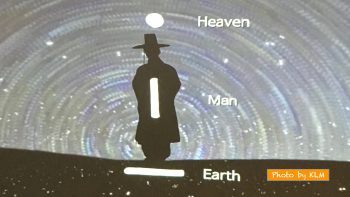The Scientific and Phonetic Korean Script, 한글(Hangeul): Vowels #3 Posted by Kyung-Hwa on Aug 2, 2017 in Grammar, Korean Language, Vocabulary
This is another portion of the series about the Korean script, 한글. The following article will cover Korean vowels and their sounds, in order to help you to build fluency in Korean, especially in reading and writing.
The first post in this series covered a brief history of 한글 and how to form syllables in Korean. The second post covered the explanation of the 19 Korean consonants and their sounds. This post will cover more detailed information of the 21 Korean vowels, including three basic symbols, 10 basic vowels, 11 complex vowels, and how to decode Korean syllables.
21 Korean Vowels
ㅏ ㅑ ㅓ ㅕ ㅗ ㅛ ㅜ ㅠ ㅡ ㅣ ㅐ ㅒ ㅔ ㅖ ㅘ ㅙ ㅚ ㅝ ㅞ ㅟ ㅢ
Three Basic Symbols
Interestingly, the following three elements of heaven/sky, man, and earth, were used to create Korean vowels.
- • : this stroke is a depiction of the heaven/sky.
* When you add this stroke to a horizontal or vertical stroke, ㅡ orㅣ, it looks like “- or ı ” instead of •
ex) the vowel ㅏ is the combination of ㅣand •
ex) the vowel ㅜ is the combination of ㅡ and •
- ㅣ : this stroke is a depiction of a man standing.
- ㅡ : this stroke is a depiction of earth, the flat land

10 Basic Vowels
The following is the list of 10 basic vowels and their sounds.
- ㅏ (a as in ah)
- ㅑ (ya)
- ㅓ (eo/uh)
- ㅕ (yeo)
- ㅗ (oh)
- ㅛ (yo)
- ㅜ (oo)
- ㅠ (yoo/you)
- ㅡ (eu)
- ㅣ (ee)
11 Complex Vowels
The following is the list of 11 complex vowels and their sounds.
- ㅐ (a as in apple)
- ㅒ (yae)
- ㅔ (e)
- ㅖ (ye)
- ㅘ (wa)
- ㅙ (wae)
- ㅚ (oe)
- ㅝ (wo)
- ㅞ (wei)
- ㅟ (wi)
- ㅢ (eu-ee)
Now you will learn the sounds of 21 vowels. However, it is important to note that the sounds of the Korean letters do not perfectly match with English sounds. I added the closest sound values in English to help your understanding.
If you are interested in practicing each vowel and related vocabulary, please click the following link.
http://www.indiana.edu/~koreanrs/hangul.html
How to decode Korean syllables
Do you remember the two different combinations of Korean syllables from my first post? Since you learned all the letters of Korean consonants and vowels, now you can now try to read Korean syllables by following these fundamental as follows.
- C (consonant) + V (vowel) examples
♣ 자 (ja)= ㅈ(j) + ㅏ(a)
*자 means a ruler in Korean.
♣ 바나나 = ㅂ(b) +ㅏ(a) ㄴ(n) + ㅏ(a) ㄴ(n) + ㅏ(a)
* 바나나 means a banana in Korean.
♣ 소 = ㅅ(s) + ㅗ(oh)
* 소 means a cow in Korean.
- C (consonant) + V (vowel) + C (consonant).
♣ 산 (san) = ㅅ(s) + ㅏ(a) + ㄴ (n)
* 산 means a mountain in Korean.
♣ 눈 (noon) = ㄴ (n) + ㅜ (oo) + ㄴ (n)
* 눈 means an eye in Korean.
♣ 돈 = ㄷ (d) + ㅗ (oh) + ㄴ (n)
* 돈 means money in Korean.
I really hope this series of articles about the Korean script has helped you in your understanding of the Korean consonants and its sounds.
By the way, don’t forget to check out my next article on stoke orders for all of the consonants and vowels.
감사합니다! (Thank you!)

Build vocabulary, practice pronunciation, and more with Transparent Language Online. Available anytime, anywhere, on any device.



